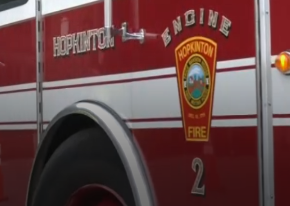
Chief William Miller and the Hopkinton Fire Department would like to remind residents to check their smoke and carbon monoxide alarms when setting their clocks ahead for daylight saving time this weekend.
Daylight saving time begins at 2 a.m. Sunday, March 12, and clocks are moved ahead one hour at that time.
According to the National Fire Protection Association (NFPA), from 2014-2018, almost three out of every five home fire deaths resulted from fires in homes with no smoke alarms (41%) or no working smoke alarms (16%). Smoke alarms that are properly installed and maintained are crucial life-saving devices that give you time to escape in the event of a fire. The risk of dying in reported home structure fires is 55% lower in homes with working smoke alarms than in homes with no alarms or none that worked, according to the NFPA.
According to the Centers for Disease Control and Prevention, each year, more than 400 people in the U.S. die from unintentional CO poisoning not linked to fires, more than 100,000 visit the emergency room, and more than 14,000 are hospitalized.
Residents are encouraged to review the following safety tips, courtesy of the NFPA, to keep their homes and families safe:
Test all smoke and CO alarms at least once a month, pressing the test button to ensure the alarm functions properly.
Smoke alarms with non-replaceable 10-year batteries are designed to remain effective for up to 10 years. If the alarm chirps warning that the battery is low, replace the entire smoke alarm right away.
Alarms with any other type of battery need a new battery at least once a year. When you change your clocks, also replace regular batteries in smoke and carbon monoxide alarms.
Smoke and CO alarms should be maintained and replaced according to the manufacturer’s instructions.
Smoke alarms should be installed inside each bedroom, outside each sleeping area and on every level of the home, including the basement.
On levels without bedrooms, install alarms in the living room (or den or family room) or near the stairway to the upper level, or in both locations.
CO alarms should be installed in a central location outside each sleeping area and on every level of the home and in other locations where required by applicable laws, codes or standards.
For the best protection, interconnect all smoke alarms, and all CO alarms. When one sounds, they all sound.
If the CO alarm sounds, immediately exit the house or building and move outside to an area of fresh air, ensuring each person inside the home is accounted for. Then call 911 and await instructions from emergency personnel.
Working with each member of the household, create and practice a home escape plan.
The NFPA also notes that today’s smoke alarms are more technologically advanced to respond to a multitude of fire conditions, yet mitigate false alarms. Residents are reminded that smoke and carbon monoxide alarms are not interchangeable and should never be disconnected.
For additional information on installing and maintaining smoke alarms, click following link: https://www.nfpa.org/Public-Education/Staying-safe/Safety-equipment/Smo…..
For additional information on CO alarm safety, click following link: https://www.nfpa.org/Public-Education/Staying-safe/Safety-equipment/Car…















